MENU
STIDS 2012 Home
About--
Topic list
Program Committee
Venue & Local info
Registration
Sponsors
Program--
Keynote Speakers
Tutorials
Best Paper Award
Agenda & Papers
Download Agenda
Proceedings
Call for Papers
Important dates
Submission details
Download CFP
Attendees
C4I
Home

SEMANTIC
TECHNOLOGY FOR
INTELLIGENCE,
DEFENSE, AND
SECURITY
Wednesday, October 24th
| 08:00 - 09:00 | Registration and Breakfast | ||
| 09:00 - 09:10 | Initial remarks - Paulo Costa, STIDS 2012 Co-Chair | ||
| 09:10 - 09:30 | Welcome - Mark Pullen, Director of the C4I Center | ||
| 09:30 - 10:30 | Keynote Address | ||
|
Mike Dean A Pragmatic View of the Semantic Web and Ontologies Presentation  I continue to be excited about the accomplishments and potential of the
Semantic Web and related technologies. In this talk, I'll review some
of those accomplishments, present some applications, discuss various
emerging technologies (Wikidata, GeoSPARQL, SILK, PROV, Big Data,
stream processing, etc.), identify some things that are still missing,
and perhaps offer some predictions for the future.
(Bio)
I continue to be excited about the accomplishments and potential of the
Semantic Web and related technologies. In this talk, I'll review some
of those accomplishments, present some applications, discuss various
emerging technologies (Wikidata, GeoSPARQL, SILK, PROV, Big Data,
stream processing, etc.), identify some things that are still missing,
and perhaps offer some predictions for the future.
(Bio)
|
|||
| 10:30 - 11:00 | Break | ||
| 11:00 - 12:00 | Research Session - Chair: Dan Maxwell, KaDSci, Inc. | ||
| 11:00 - 11:30 |
Using Ontologies in a Cognitive-Grounded System: Automatic Action Recognition in Video-Surveillance Paper Presentation |
Alessandro Oltramari, Christian Lebiere Carnegie Mellon University |
|
|
Abstract
This article presents an integrated cognitive system for automatic video-surveillance: in particular, we focus on
the task of classifying the actions occurring in a scene. For this purpose, we developed a semantic infrastructure
on top of a hybrid computational ontology of actions. The article outlines the core features of this infrastructure,
illustrating how the processing mechanisms of the cognitive system benefit from knowledge capabilities in fulfilling
the recognition goal. Ultimately, the paper demonstrates that ontologies can enhance a cognitive architecture's
functionalities, allowing for high-level performance in complex task execution. |
|||
| 11:30 - 12:00 |
Horizontal Integration of Warfighter Intelligence Data: A Shared Semantic Resource for the Intelligence Community Paper Presentation |
Barry Smith (a), Tatiana Malyuta (b), William S. Mandrick (b), Chia Fu (b), Kesny Parent ( c), Milan Patel (c) a. University at Buffalo, b. Data Tactics Corp., c. Intelligence and Information Warfare Directorate (I2WD) |
|
|
Abstract
We describe a strategy that is being used for the horizontal integration of warfighter intelligence data within
the framework of the US Army's Distributed Common Ground System Standard Cloud (DSC) initiative. The strategy
rests on the development of a set of ontologies that are being incrementally applied to bring about what we call
the 'semantic enhancement' of data models used within each intelligence discipline. We show how the strategy
can help to overcome familiar tendencies to stovepiping of intelligence data, and describe how it can be applied
in an agile fashion to new data resources in ways that address immediate needs of intelligence analysts. |
|||
| 12:00 - 13:30 | Lunch | ||
| 13:30 - 15:00 | Research Session - Chair: Robert Schrag, Digital Sandbox, Inc. | ||
| 13:30 - 14:00 |
Constellation: A Prototype ISO/IEC 11179 Metadata Registry
Paper Presentation |
Gramm Richardson(a), Elli Schwarz(b) a. US DOD and b. SRA International |
|
|
Abstract
Different systems across the government, as well as in the private sector, use different country names or country codes
to represent the notion of a "country" within a particular problem domain. These systems may choose to represent countries
using a particular standard for county names and country codes. Often times these systems find themselves interacting with
other systems that may use another standard for country representation. This makes it difficult to compare and link
country-related data in a consistent fashion. We describe our work on the Constellation system using the ISO/IEC 111179
metadata standard to register the various country code sets in a common metamodel. This facilitates management, querying,
updating and mapping the elements within the code sets. |
|||
| 14:00 - 14:30 |
The URREF Ontology for Semantic Wide Area Motion Imagery Exploitation Presentation |
Erik Blasch(a), Paulo Costa (b), Kathryn Laskey (b), Haibin Ling ( c), Genshe Chen (d) b. George Mason University, c. Temple University, d. Information Fusion Tech |
|
|
Abstract
Current advances operational information fusion systems (IFSs) require common semantic ontologies for collection,
storage, and access to multi intelligence information. One example is the connections between physics-based (e.g. video)
and text-based (e.g. reports) describing the same situation. Situation, user, and mission awareness are enabled through
a common ontology. In this paper, we utilize the uncertainty representation and reasoning evaluation framework (URREF)
ontology as a basis for describing wide-area motion imagery (WAMI) analysis to determine uncertainty attributes. As part
of the Evaluation of Technologies for Uncertainty Representation Working Group (ETURWG), both the URREF and a WAMI
challenge problem are available for research purposes from which we describe the URREF, a exemplar schema to link
physics-based and text-based uncertainty representations, and explore an example from WAMI exploitation for a
common uncertainty demonstration. |
|||
| 14:30 - 15:00 |
Developing an Ontology of the Cyber Security Domain
Paper Presentation |
Leo Obrst, Penny Chase, Richard Markeloff The MITRE Corporation |
|
|
Abstract
This paper reports on a trade study we performed to support the development of a Cyber ontology from an initial
malware ontology. The goals of the Cyber ontology effort are first described, followed by a discussion of the
ontology development methodology used. The main body of the paper then follows, which is a description of the
potential ontologies and standards that could be utilized to extend the Cyber ontology from its initially constrained
malware focus. These resources include, in particular, Cyber and malware standards, schemas, and terminologies that
directly contributed to the initial malware ontology effort. Other resources are upper (sometimes called 'foundational')
ontologies. Core concepts that any Cyber ontology will extend have already been identified and rigorously defined in
these foundational ontologies. However, for lack of space, this section is profoundly reduced. In addition, utility
ontologies that are focused on time, geospatial, person, events, and network operations are briefly described. These
utility ontologies can be viewed as specialized super-domain or even mid-level ontologies, since they span many, if not
most, ontologies -- including any Cyber ontology. An overall view of the ontological architecture used by the trade study
is also given. The report on the trade study concludes with some proposed next steps in the iterative evolution of the
Cyber ontology. |
|||
| 15:00 - 15:30 | Break | ||
| 15:30 - 17:00 | Research Session - Chair: Charles Twardy, George Mason University | ||
| 15:30 - 16:00 |
Ontological Considerations for Uncertainty Propagation in High Level Information Fusion Paper Presentation |
Mark Locher(a,b), Paulo Costa(a) a. GMU and b. SRA International |
|
|
Abstract
Uncertainty propagation in a level 2 high level information fusion (HLIF) process is affected by a number of
considerations. These include the varying complexities of the various types of level 2 HLIF. Five different
types are identified, ranging from simple entity attribute refinement using situation status data to the
development of a complete situation assessment assembled from applicable situational fragment data. Additional
considerations include uncertainty handling in the input data, uncertainty representation, the effects of the
reasoning technique used in the fusion process, and output considerations. Input data considerations include
the data's relevance to the situation, its credibility, and its force or weight. Uncertainty representation
concerns follow the uncertainty ontology developed by the W3C Incubator Group on Uncertainty Reasoning. For
uncertainty effects of the fusion process, a basic fusion process model is presented, showing the impacts of
uncertainty in four areas. Finally, for output uncertainty, the significance of a closed-world versus
open-world assumption is discussed. |
|||
| 16:00 - 16:30 |
A Semantic Approach to Evaluate the Impact of Cyber Actions to the Physical Domain Paper Presentation |
Alexandre Barreto (a,b), Paulo Costa (a), Edgar Yano (b) a. C4I Center, George Manson University and b. Inst. Technológico de Aeronáutica, Brazil |
|
|
Abstract
Evaluating the impact that events within the cyber domain inflict to a military operation and its critical
infrastructure is a non-trivial question, which remains unanswered so far in spite of the various research
efforts addressing it. The key issue underlying this question is the difficulty in correlating cyber and physical
behaviors in an integrated view, thus allowing for real-time task evaluation. This paper addresses the issue
with the development of an ontology-based framework in which the cyber and physical behaviors are integrated
in a consolidated view, using a combination of open standards protocols and semantic technologies. In our
approach, the mission and its physical aspects are modeled using a business process language (e.g., BPMN)
and an information infrastructure based on Simple Network Management Protocol (SNMP). In this scheme, changes
in the environment are captured using the output of sensor components existing in the infrastructure. In order
to ensure a complete and integrated analysis of the accruing data, we have developed a Cyber Situation ontology
(in OWL language) and a methodology for mapping the cyber and the physical domains. In this framework, mission
data from the environment is retrieved and fused using an engine based on the semantic rule language (SWRL).
The output of this process is then presented to an analyst in a way that only the most important information
needed to support his/her decisions is shown. To validate our approach, a fictitious air traffic scenario was
modeled and many simulated flights were generated in support to our experiments. |
|||
| 16:30 - 17:00 |
Intrinsically Resilient Energy Control Systems Paper Presentation |
Frederick Sheldon (a), Jingshan Huang (b), Jiangbo Dang( c), Daniel Fetzer (a), Stuart Goose( c), Jonathan Kirsch ( c), David Manz (d), Thomas Morris (e), Dong Wei (c) a. Oak Ridge Natl Laboratory, b. University of S. Alabama, c. Siemens Corporation, d. Pacific NW Natl Laboratory, e. Mississippi St. University |
|
|
Abstract
To preserve critical energy control functions while under attack, it is necessary to perform comprehensive analysis
on the root cause and impact of an ongoing cyber intrusion without sacrificing the availability of energy delivery.
In this position paper, we present a proof of concept of an intrinsically resilient energy control system, with the
ultimate goal of ensuring availability/resiliency of energy delivery functions, along with the capability to assess
root causes and impacts of cyber intrusions. |
|||
| 17:00 - 18:30 |
Poster Session / Social Event |
||
|
Study of MEBN Learning for Relational Model
Paper Presentation |
Cheol Young Park, Kathryn Blackmond Laskey, Paulo Costa, Shou Matsumoto George Mason University |
||
|
Abstract
In the past decade, Statistical Relational Learning (SRL) has emerged as a new branch of machine learning for
representing and learning a joint probability distribution over relational data. Relational representations
have the necessary expressive power for important real-world problems, but until recently have not supported
uncertainty. Statistical relational models fill this gap. Among the languages recently developed for statistical
relational representations is Multi-Entity Bayesian Networks (MEBN). MEBN is the logical basis for Probabilistic
OWL (PR-OWL), a language for uncertainty reasoning in the Semantic Web. However, until now there has been no
implementation of MEBN learning. This paper describes the first implementation of MEBN learning. The algorithm
learns a MEBN theory for a domain from data stored in a relational Database. Several issues are addressed such
as aggregating influences, optimization problem, and so on. In this paper, as our contributions, we will provide
a MEBN-RM (Relational Model) Model which is a bridge between MEBN and RM, and suggest a basic structure learning
algorithm for MEBN. And the method was applied to a test case of a maritime domain in order to prove our
basic method. |
|||
|
Social Sifter: An Agent-Based Recommender System to Mine the Social Web Paper |
M. Omar Nachawati, Rasheed Rabbi, Genong (Eugene) Yu, Larry Kerschberg, Alexander Brodsky George Mason University |
||
|
Abstract
With the recent growth of the Social Web, an emerging challenge is how can we integrate information from the
heterogeneity of current Social Web sites to improve semantic access to the information and knowledge across the
entire World Wide Web. While each individual Social Web site may provide its own semantic facilities, when it
comes to interoperability across the Social Web in its entirety, even the simplest of inferences based on data
from different sites can appear intractable without the Ňsemantic training wheelsÓ pioneered by the Semantic Web
effort. Even if such data were interoperable across multiple Social Web sites, the ability of a system of collective
intelligence to make meaningful inferences, depends largely on both its ability to marshal such semantic data as
well as its ability to understand accurately and respond precisely to queries from its users.
|
|||
Thursday, October 25th
| 08:30 - 09:00 | Breakfast | ||
| 09:00 - 10:00 | Keynote Speaker | ||
|
Jay Holcomb An Insider Perspective of how Semantic Technologies are supporting the DHS efforts in Cybersecurity  U.S. Computer Emergency Readiness Team
U.S. Computer Emergency Readiness TeamNational Cyber Security Division (NCSD) U.S. Department of Homeland Security |
|||
| 10:00 - 10:30 | Break | ||
| 10:30 - 12:00 | Research Session Chair: - Richard Lee, Booz Allen Hamilton | ||
| 10:30 - 11:00 |
D2RCrime: A Tool for Helping to Publish Crime Reports on the Web from Relational Data Paper Presentation |
Julio Tavares, Vasco Furtado, Henrique Santos, Eurico Vasconcelos Universidade de Fortaleza, Brazil |
|
|
Abstract
In the Law Enforcement context more and more data about crime occurrences are becoming available to the general
public. For an effective use of open data, it is desirable that the different sources of information follow a
pattern, which allows reliable comparisons. In addition, it is expected that the task of creating a correspondence
between the pattern and the internal representations of each source of information is not a steep learning curve.
These two conditions are hardly found in the actual stage where open data about crime occurrences is referred to
as the data opened by each police department in its own way. This paper proposes an interactive tool, called
D2RCrime, that assists the designer/DBA of relational crime databases to make the correspondence between the
relational data and the classes and properties of a crime ontology. The ontology plays the role of a pattern to
represent the crime concepts and crime report and is also the interface to publish on-the-fly relational
crime data. This correspondence allows the automatic generation of mapping rules between the two representations,
what allows for accessing relational data from SPARQL. An evaluation of D2RCrime is done with DBA/System analysts
who used the tool for establishing correspondences between relational data and the ontology. |
|||
| 11:00 - 11:30 |
Exploiting inference to improve temporal RDF annotations and queries for machine reading Paper Presentation |
Robert Schrag Digital Sandbox, Inc. |
|
|
Abstract
We describe existing and anticipated future benefits of an end-to-end methodology for annotating formal RDF
statements representing temporal knowledge to be extracted from text, as well as for authoring and validating
test and/or application queries to exercise that knowledge. Extraction is driven by a target ontology of
temporal and domain concepts supporting an intelligence analystŐs timeline tool. Both the tool and the methodology
are supported at several points by an implemented temporal reasoning engine, in a way that we argue ultimately
advances machine reading technology by increasing both sophistication and quality expectations about temporal
annotations and extraction. |
|||
| 11:30 - 12:00 |
Best-practice Time Point Ontology for Event Calculus-based Temporal Reasoning Paper Presentation |
Robert Schrag Digital Sandbox, Inc. |
|
|
Abstract
We argue for time points with zero real-world duration as a best ontological practice in point and interval-based
temporal representation and reasoning. We demonstrate anomalies that unavoidably arise in the event calculus when
real-world time intervals corresponding to finest anticipated calendar units (e.g., days or seconds, per application
granularity) are taken (naively or for implementation convenience) to be time "points." Our approach to eliminating
the undesirable anomalies admits durations of infinitesimal extent as the lower and/or upper bounds that may
constrain two time points' juxtaposition. Following Dean and McDermott, we exhibit axioms for temporal constraint
propagation that generalize corresponding na•ve axioms by treating infinitesimals as orthogonal first-class quantities
and we appeal to complex number arithmetic (supported by programming languages such as Lisp) for straightforward
implementation. The resulting anomaly-free operation is critical to effective event calculus application in
commonsense understanding applications, like machine reading. |
|||
| 12:00 - 13:30 | Lunch | ||
| 13:30 - 14:45 | Panel - Moderator: Leo Obrst | ||
|
Cyber Ontology: Is it the World Squared? Panelists Info Obrst intro Presentation - Mike Dean Presentation - Duminda Wijesekera Presentation - Brian Haugh |
Mike Dean - Raytheon BBN Technologies Duminda Wijesekera - C4I Center - GMU Brian Haugh - Institute for Defense Analyses Bill Mandrick - Data Tactics Randall Dipert - University at Buffalo |
||
| 14:45 - 15:15 | Break | ||
| 15:15 - 16:45 | Research Session - Chair: Richard Markeloff, MITRE Corp | ||
| 15:15 - 15:45 |
The Why Agent: Enhancing user trust in automation through explanation dialog Paper Presentation |
Rob Cole(a), Jim Jacobs(a), Michael Hirsch(a), Robert L. Sedlmeyer(b, c) a. Raytheon Company, b. Indiana University, c. Purdue University |
|
|
Abstract
Lack of trust in autonomy is a recurrent issue that is becoming more and more acute as manpower reduction
pressures increase. We address the socio-technical form of this trust problem through a novel decision
explanation approach. Our approach employs a semantic representation to capture decision-relevant concepts
as well as other mission-relevant knowledge along with a reasoning approach that allows users to pose queries
and get system responses that expose decision rationale to users. This representation enables a natural,
dialog-based approach to decision explanation. It is our hypothesis that the transparency achieved through
this dialog process will increase user trust in autonomous decisions. We tested our hypothesis in an experimental
scenario set in the maritime autonomy domain. Participant responses on psychometric trust constructs were
found to be significantly higher in the experimental group for the majority of constructs, supporting our
hypothesis. Our results suggest the efficacy of incorporating a decision explanation facility in systems
for which a socio-technical trust problem exists or might be expected to develop. |
|||
| 15:45 - 16:15 |
Rapid Argumentation Capture from Analysis Reports: The Case Study of Aum Shinrikyo Paper Presentation |
Mihai Boicu, Gheorghe Tecuci, Dorin Marcu Learning Agents Center, George Mason University | |
|
Abstract
The availability of subject matter experts has always been a challenge for the development of
knowledge-based cognitive assistants incorporating their expertise. This paper presents an approach
to rapidly develop cognitive assistants for evidence-based reasoning by capturing and operationalizing
the expertise that was already documented in analysis reports. It illustrates the approach with the
development of a cognitive assistant for assessing whether a terrorist organization is pursuing weapons
of mass destruction, based on a report on the strategies followed by Aum Shinrikyo to develop and use
biological and chemical weapons. |
|||
| 16:15 - 16:45 |
A Policy-Based Dialogue System for Physical Access Control Paper Presentation |
Mohammad Ababneh (a), Duminda Wijesekera(a), James Bret Michael(b) a. George Mason University b. Naval Postgraduate School |
|
|
Abstract
We prototype a policy-based dialog system for providing physical access control to secured facilities and
smart buildings. In our prototype system, physical access control policies are specified using the
eXtensible Access Control Markup Language. Based on the policy and the user's presence information, our
dialog system automatically produces a series of questions and answers that, if correctly answered, permit
the requester to enter the secure facility or smart building. The novelty of this work is the system's
ability to generate questions appropriate to the physical location, time of day, and the requester's
attributes. |
|||
| 16:45 - 17:00 | Best Paper Award - Chair: Daniel Maxwell | ||
| 17:00 - 17:15 | Wrap Up - Paulo Costa | ||
